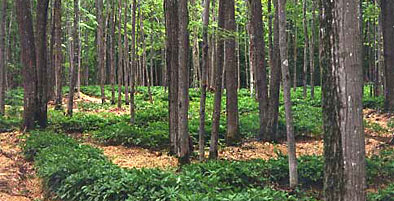Wasabi is generally thought of as a pungent green paste that accompanies sushi. That green paste is more often than not, made up of grated horseradish or mustard. In this video, we take a look at the plant whose grated root makes up the real wasabi. It was traditionally eaten with sushi to combat food poisoning that can result from eating raw fish. Today, it’s considered as the natural condiment for sushi. Joe Hollis, founder of Mountain Gardens, explains what wasabi is and where it prefers to grow. It likes to have fresh, cold water running over its roots but does not like for its crown to be submerged in water. The mountain springs of Japan are its traditional habitat but it has been grown successfully in the Pacific Northwest and in the mountains of Appalachia. It requires annual cold temperatures and dappled lighting of deciduous forests.
Wasabi plants send up a flower stalk in spring that then produces seeds. Once the seed pods form, the stalk bends over to the ground and the seeds are often dispersed into the soil. In order for germination to occur, the seed must remain moist and go through a cold period of below 40 degrees for nearly six weeks. Hollis explains that in the mountains of North Carolina, wasabi generally endures cold temperatures for much longer than six weeks without being affected. To collect the seed pods before they reach the soil, Hollis places a wire cage over the plant. The stalks then grow up through the holes and eventually drape over cage, making collection easier. It is possible to collect the seeds and store them in moist peat moss in the refrigerator until the following spring, but often it’s best to plant them right away.
After collecting wasabi pods from the plants, the seeds should be shaken from the pods before planting. Joe Hollis uses several wire screens to shake the seed pods and extract the seed. Once the seed is collected, it should be planted or stored in a moist medium such as peat moss and kept in the refrigerator. Wasabi seed needs a cold period of at least six weeks below 40 degrees. If holding it over in the refrigerator, it can be planted the following spring. Joe Hollis uses soil composed of shredded bark, leaf mold and perlite which promotes drainage. Roughly twenty seeds can be planted in one small pot; however, planting in larger pots may result in better chances of germination. After covering the seeds with a light layer of soil, granite grit can be sprinkled on top to help protect the seed from the elements.
In Japan, the most desirable wasabi rhizomes are reproduced via tissue culture, thus replicating the largest and most flavorful wasabi roots. Essentially, a tissue culture provides a clone of the plant. Wasabi can also be grown by seed. This method takes longer to produce a mature plant and also provides variability among plants. The rhizomes are generally long and thin and don’t resemble the Japanese varieties at all. Joe Hollis experiments with rhizome propagation in this video. By cutting the wasabi rhizome in small, quarter-inch pieces, he hopes to grow plants more quickly than from seed.
Wasabi traditionally grows in the cool, mountain springs of Japan. While successfully grown in similar conditions within the Pacific Northwest and Appalachian mountains, it is also possible to simulate conditions to favor the native habitat. Joe Hollis explains how a child’s swimming pool can be converted into a bed for growing wasabi. The small pool should be filled with large rocks on the bottom and then filled with soil. A hole should be drilled in one bottom corner to provide drainage. The entire pool should then be tilted with a supply of cool water trickling into the opposite side from the hole. This set up provides adequate drainage for wasabi plants and should work in a setting that experiences weather below 40 degrees during the winter.
To harvest wasabi, use a pitch fork or large spade to dig up the plant. The rhizome can be grated and the leaves can be eaten or ground up for salad dressings etc. Harvesting only the leaves would be more sustainable when starting wasabi as a forest crop. They can be marketed to restaurants for use in a variety of applications.
